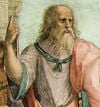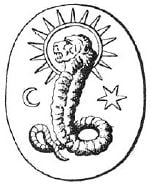Demiurge
Demiurge (from the Greek δημιουργός dēmiourgós, Latinized demiurgus, meaning "artisan" or "craftsman") is a term for a creator deity or divine artisan responsible for the creation of the physical universe.
The word was first introduced in this sense by Plato in his Timaeus, 41a (ca. 360 B.C.E.). It subsequently appears in a number of different religious and philosophical systems of Late Antiquity, most notably in Neoplatonism and Gnosticism. Three separate meanings of the term may be distinguished.
- For Plato, the Demiurge is a benevolent creator of the laws, heaven, or the world.
- Plotinus identified the Demiurge as nous (divine reason), the first emanation of "the One" (see monad). Neoplatonists personified the Demiurge as Zeus.
- In Gnosticism, the material universe is seen as evil, and the Demiurge is the evil creator of the physical world.
Alternative Gnostic names for the Demiurge include Yaldabaoth, Yao or Iao, Ialdabaoth and several other variants. The Gnostics often identified the Demiurge with the Hebrew God Yahweh (see the Sethians and Ophites). In Mandaeanism the Demiurge is known as Ptahil
Platonism and Neoplatonism
| Part of a series on Platonism |
| Platonic idealism |
| Platonic realism |
| Middle Platonism |
| Neoplatonism |
| Articles on Neoplatonism |
| Platonic epistemology |
| Socratic method |
| Socratic dialogue |
| Theory of forms |
| Platonic doctrine of recollection |
| Form of the Good |
| Individuals |
| Plato |
| Socrates |
| Alcibiades |
| Protagoras |
| Parmenides |
| Discussions of Plato's works |
| Dialogues of Plato |
| Metaphor of the sun |
| Analogy of the divided line |
| Allegory of the cave |
| Third Man Argument |
| Quis custodiet ipsos custodes? |
Plato's character Timaeus refers to the Demiurge frequently in the Socratic dialogue which bears his name, written around 360 B.C.E. Timaeus refers to the demiurge as the entity who “fashioned and shaped” the material world. He describes this being as unreservedly benevolent and hence desirous of a world as good as possible. The world remains allegedly imperfect, however, because the Demiurge had to work with pre-existing chaotic matter.
Plato's Demiurge is seen as a fleshing out of Hesiod's cosmology in the work Theogeny in the context of the dialectical discourse between Timaeus and the other guests at the gathering in Plato's dialog.
Timaeus suggests that since nothing "becomes or changes" without a cause, there must be a cause of the universe itself. Timaeus thus refers to the Demiurge as the father of the universe. Moreover, since the universe is fair, the Demiurge must have used the eternal and perfect world of "forms" or ideals as a template. He then set about creating the world, which formerly only existed in a state of disorder. Timaeus states that it is "blasphemy to state that the universe was not created in the image of perfection or heaven."
For Neoplatonist writers like Plotinus, the Demiurge was not the originator of the universe, but a second creator or cause (see Dyad). The first and highest God is the One, the source, or the Monad. The Monad emanated the Nous, divine mind or reason, which Plotinus referred to figuratively as the Demiurge. In this he claimed to reveal Plato's true meaning, a doctrine he learned from Platonist tradition but did not appear outside the academy or in Plato's texts.
As Nous, the Demiurge is part of the three ordering principles:
- arche - the source of all things,
- logos - the underlying order that is hidden beneath appearances
- harmonia - numerical ratios in mathematics.
In relation to the gods of mythology the Demiurge is identified as Zeus within Plotinus' works.
Gnosticism
Like Plato, Gnosticism also presents a distinction between the highest, unknowable God and the demiurgic “creator” of the material world. However, in contrast to Plato, several systems of Gnostic thought present the Demiurge as antagonistic to the will of the Supreme Being. His act of creation either occurs in unconscious imitation of the divine model, and thus is fundamentally flawed, or else is formed with the malevolent intention of entrapping aspects of the divine in materiality. In such systems, the Demiurge acts as a solution to the problem of evil.
In the Apocryphon of John circa 200 C.E., the Demiurge has the name “Yaltabaoth,” and proclaims himself as God:
- “Now the archon (ruler) who is weak has three names. The first name is Yaltabaoth, the second is Saklas ('fool'), and the third is Samael. And he is impious in his arrogance which is in him. For he said, ‘I am God and there is no other God beside me,’ for he is ignorant of his strength, the place from which he had come.”[1]
Yaldabaoth
“Yaldabaoth” may literally mean “Child, come here." The Hebrew word for “young girl” is yalda, and the word for “come” is bo. Thus, most probably “yaldabaoth” is a declension of “young girl” and “come,” together meaning “young girl, come hither.”
Gnostic myth recounts that Sophia (Greek, literally meaning “wisdom”), the Demiurge’s mother and a partial aspect of the divine Pleroma or “Fullness,” desired to create something apart from the divine totality. However, she did this without divine assent. In this abortive act of separate creation, she gave birth to the monstrous Demiurge and, being ashamed of her deed, she wrapped him in a cloud and created a throne for him within it. The Demiurge, isolated, did not behold his mother, nor anyone else. Being ignorant of the superior levels of reality that were his birth-place.and thus concluded that only he himself existed.
The Gnostic myths describing these events are full of intricate nuances and variations portraying the declination of aspects of the divine into human form. This process occurs through the agency of the Demiurge who, having stolen a portion of power from his mother, sets about a work of creation in unconscious imitation of the superior realm. Thus Sophia’s power becomes enclosed within the material forms of humanity, themselves entrapped within the material universe. The goal of Gnostic movements was typically the awakening of this divine spark of wisdom, enabling the enlightened soul to return to the superior, non-material realities which were its primal source. (See Sethian Gnosticism.)
Under the name of Nebro, Yaldabaoth is called an angel in the apocryphal Gospel of Judas. He is first mentioned as one of the 12 angels to come “into being [to] rule over chaos and the [underworld].” He comes from heaven, his “face flashed with fire and whose appearance was defiled with blood.” Nebro’s name means rebel. He creates six angels in addition to the angel Saklas to be his assistants. These six in turn create another 12 angels “with each one receiving a portion in the heavens.”
Samael
“Samael” literally means “Blind God” or “God of the Blind” in Aramaic (Syriac sæmʕa-ʔel). This being is considered not only blind, or ignorant, of its own origins, but is also apparently intentionally evil. The name Samael is also found in Judaica as the Angel of Death and also in Christian demonology. This leads to a further comparison with Satan.
Yahweh
Some Gnostic or semi-Gnostic philosophers (notably Marcion of Sinope and the Sethians) identified the Demiurge with Yahweh, the wrathful God of the Old Testament, in opposition and contrast to the benevolent God of the New Testament.
Satan is called "the god of this world" at (2 Cor. 4:4), and John states that "the whole world lies in the grip of the Wicked One." (1 John 5:19) For some, Satan is thus Father of the "original lie," as the creator of the physical world as we know it.
This distinguishes the God of the Old Testament from the God of the New; the God of the New possessing a single purpose unblemished by the uncertainty that duality implies. Meanwhile, the New Testament concepts such as the spiritual as good and the body as evil reflected a clear duality as expressed within the Sethian and other Gnostic traditions
Neoplatonic Criticism
Plotinus criticized Gnosticism in the ninth tractate of the second Enneads, entitled: "Against Those That Affirm the Creator of the Cosmos and the Cosmos Itself to Be Evil.' Plotinus criticizes his opponents for “all the novelties through which they seek to establish a philosophy of their own” which, he declares, “have been picked up outside of the truth”; they attempt to conceal rather than admit their indebtedness to ancient philosophy, which they have corrupted by their extraneous and misguided embellishments.
Where as Plato's demiurge is good wishing good on his creation, gnosticism contends that the demiurge is not only the originator of evil but is evil as well.
The majority view tends to understand Plotinus’ opponents as being a Gnostic sect—certainly, (specifically Sethian) several such groups were present in Alexandria and elsewhere about the Mediterranean during Plotinus’ lifetime, and several of his criticisms bear specific similarity to Gnostic doctrine (Plotinus pointing to the gnostic doctrine of Sophia and her emission of the Demiurge is most notable amongst these similarities). The Body and the cosmos as a prison or evil.
However, other scholars have contended that Plotinus’ opponents might be better described as simply “Christian Gnostics,” for the reason that several of Plotinus’ criticisms are as applicable to orthodox Christian doctrine as they are to Gnosticism.
ReferencesISBN links support NWE through referral fees
See also
|
|
External links
Credits
New World Encyclopedia writers and editors rewrote and completed the Wikipedia article in accordance with New World Encyclopedia standards. This article abides by terms of the Creative Commons CC-by-sa 3.0 License (CC-by-sa), which may be used and disseminated with proper attribution. Credit is due under the terms of this license that can reference both the New World Encyclopedia contributors and the selfless volunteer contributors of the Wikimedia Foundation. To cite this article click here for a list of acceptable citing formats.The history of earlier contributions by wikipedians is accessible to researchers here:
The history of this article since it was imported to New World Encyclopedia:
Note: Some restrictions may apply to use of individual images which are separately licensed.

